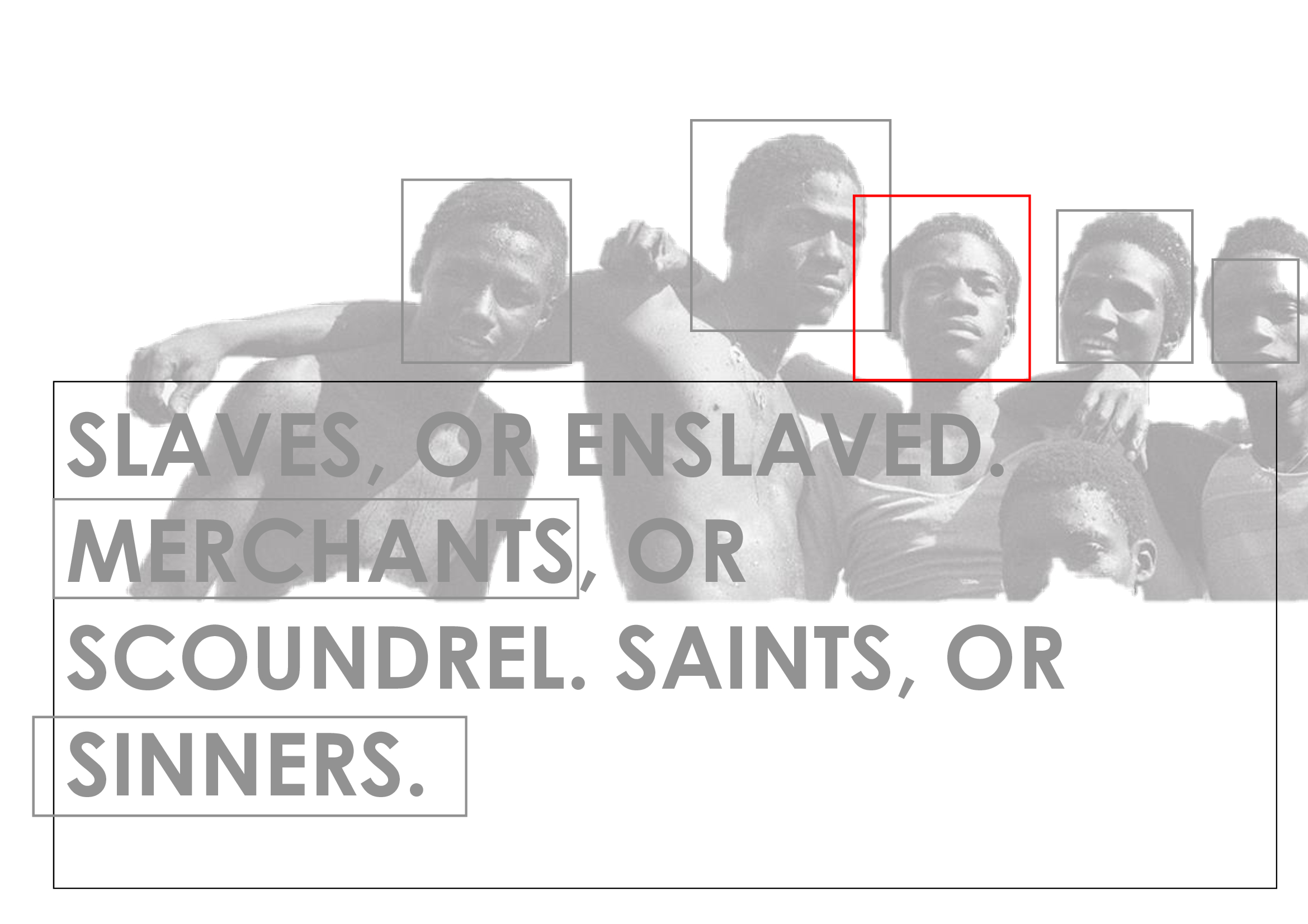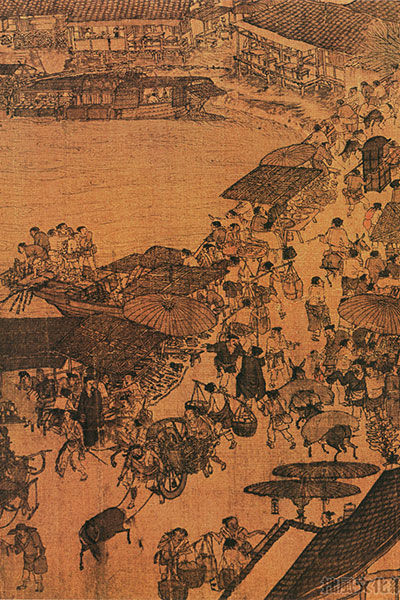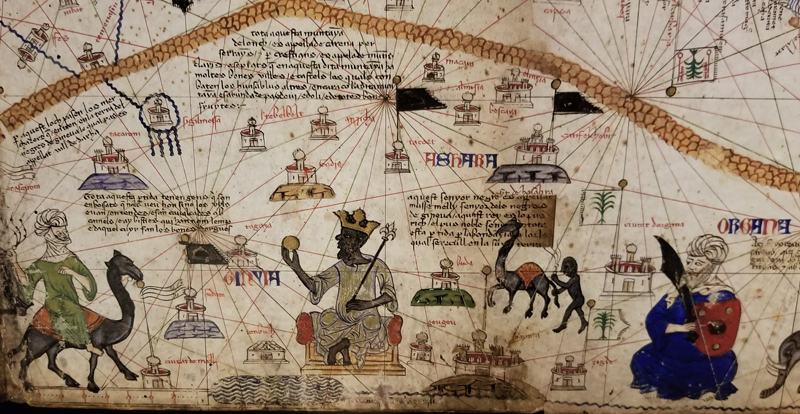-
AuthorPosts
-
-
Slave, or
Enslaved.
Merchants, or
Scoundrel.
Saints, or
Sinners.

Introduction and timeline:
Ancient Africa was not isolated from the old world.
Historical and archaeological research provides a firm understanding of the ancient trans-saharan trade, from approximately 4000 B.C (long prior to the 1st century C.E; and described as beginning with the age of African metallurgy in the case of Senegal), spanning the old Kingdom of Kush in Kerma, Sudan; through the Darb el-Arbain trade route, and encompassing commerce in incense, wheat, spices, gold, salt, animals/poultry, skilled artisan’s and ivory; and importantly, the import of minerals such as ‘obsidian’ from Senegal to create blades, objects, and metalworking. Recent anthropological research now finds Manding inscriptions in the dense forests of South America.
The Silk Routes:
Commerce carried information, and the interlocking trade networks connecting Africa to most of the Old World, brought about an exchange of trade in oriental [eastern] silks for amber, jade, dyes, spices, gold, oil, forged tools, including mythical creatures such as the giraffe [or, the qilin, revered in Chinese, Japanese and Korean mythology] e.t.c, circa 114 B.C, from the expanding Han dynasty.
The art of silk production remained an exclusive Chinese export during this period, and the Han imperial documents show diplomatic and trade relations between the Han Dynasty and Africa, with a diplomatic envoy ‘Zhang Qian’ dispatched to secure transcontinental trade, as well as create political protectorates, for the burgeoning silk trade. This practice continued into the early Ming Dynasty, with records of ‘Zheng He‘ (a Diplomat and Admiral) visiting the interior of Africa between 1419 C.E and 1433 C.E, and African envoys/ambassadors invited by Emperor Zhu Di to celebrate the very elaborate Chinese New Year at the newly constructed Forbidden City; circa 1421 C.E.
The Graeco-Roman periplus “The Periplus of the Erythraean Sea” also provided a record of the sailing itineraries and commercial opportunities between Africa and external/strategic trading ports.
The Roman Empire inherited the established trade networks that formed part of the Silk Road between the eastern trade routes and Africa, following the conquest of Egypt in 30 B.C.
Lucius Septimius Severus’s ancestry – (“Aethiops quidam e Numero Militari”):
The expanding Roman empire absorbed the trade, aristocracy and military traditions of the ruling elites of conquered sovereign-states, establishing senatorial/diplomatic relations. The immense multi-ethnic diversity that existed within the burgeoning population of the Northern African Roman Empire is listed in the Notitia Dignitatum (“The List of Administrative Roman Offices”), and as reflected in the skilled African(Aethiopes/Mauri/Moorish) military regiment forming part of the Roman Army Germania, and Britannia campaigns, and in Septimius Severus’s ancestry.
In 193 C.E, Lucius Septimius Severus was crowned ruler of all the Roman Empire and became Rome’s first African Emperor; a product of the cultural and political union/alliance between an African father, and a mother of Italian Roman descent, coming from a prominent Roman family of equestrian rank.
The most notable later expedition of Emperor Septimius Severus’s sovereignty was in the Roman province of Britannia; and where he died in York, circa 211 C.E.
During this period African’s were known by many names, and led the conquest of the Iberian Peninsula circa 711 C.E until 1492 C.E, following the fall of the Roman Dioecesis Africae (Roman Diocese of Africa), and the Roman Empire.
The silk trade in Africa continued for an extended period of time, and what is now known as ‘the silk routes, or silk road’ existed for more than 1,500 years, until approximately 1453 C.E.

The Great Zimbabwe, Malian and Ghana Empire lay on the trade route, between the east coast and the interior of Africa, giving rise to a host of middlemen and trading posts, and the requirement for taxes and protection along the way.
Religion, new technologies, innovation and ideas spread along the African trading corridors just as fluidly as goods, resulting in the growth of multicultural cities along the interior of the trans-saharan trade routes, namely Gao and Timbuktu, e.t.c.
At the peak of the African Renaissance, the well organised system of government under the leadership of King’s, such as Musa Keita I or Mansa Musa, the extensive travel and trading networks of African merchants and African Islamic scholars developed an important book trade, and establishing Timbuktu as a scholarly centre in Africa, circa 988 C.E and onwards.
As a result, tales of Africa’s wealth, exotic exports, renaissance, lifestyle and high-culture fuelled speculation in Europe, as not just being extremely rich, but also being particularly mysterious. These stories helped prompt the European interest and exploration of opportunities in Africa.
The decline of these kingdoms (African city-states) resulted from a shift in the dynamics of international trade, internal rivalries [notably, the Saadian/Moroccan invasion of the Niger interior, the Battle of Tondibi, and the Battle of Alcácer Quibir] new sailing trade routes, advanced maritime/navigation skills and weaponry, increased demand and competition for land, access to goods and resources such as gold, a shift in geographical dominance and ideology.
The political fragmentation of the region, the looting of multicultural cities, literature and treasures of centralized empires such as Mali, Songhai, the Kongo/Congo, and the increasing presence of the Ottoman‘s and Portugal marked the end of the region as an effective/dynamic force in commerce.

Background:[The beginnings of European activity in Africa.]:
Like other foreign travellers and purveyors of goods prior, African merchants and traders were certainly open to the European newcomers.
The arrival of the first European traders, over 5440 years after the exchange of (known and documented) trade began in Africa, can be linked to a young Portuguese captain ‘Antam Gonçalvez’ who, after hearing stories of the potential for trade and profit, embarked on the journey to Western Sub-Sahara Africa in 1441 C.E, under instruction of ‘Dom Henrique of Portugal, Duke of Viseu’ to obtain seal skins, black pepper, spices and oil, for onward sale in Lisbon.
Portugal was desirous to retain a monopoly on trade in Africa, and sought justification of its position, early discoveries and sphere of influence (new-found trading routes), through a Papal Bull of 1442 C.E, ordained by Pope Eugene IV, the consequence of which would be the legitimisation of enslavement of Africans as captives, under the premise and designation of the enterprise as a crusade; a Papal Bull by Pope Nicolas V, in 1452 C.E and 1455 C.E, and a Papal Bull sanctifying the Treaty of Tordesillas (in 1494 C.E).
At the time, during the 15th and 17th centuries, silver and gold were the international standards of exchange in Europe and Asia. The supply of precious metals was important to boost economies, and to back currencies for exchange and import.
The same logic and material forces were operational in the exploit of Mayan gold by Spain, and when this was exhausted, the exploits of the silver mines of Mexico. Indeed, much of the rivalry between European countries in the 15th and 18th centuries were born out of the desire to protect and bolster their economies and currencies.
The news of Portuguese exploits in Africa was heard in neighbouring Spain, and across the rest of Europe, with most feeling left out of the spoils.
Between 1495 C.E and 1559 C.E, hundreds of Portuguese ships were raided, captured and looted by the English, and likewise, the English surreptitious involvement in the Battle of Agadir (‘Santa Cruz’) 1541 C.E.
King John III of Portugal wrote to Queen Mary of England (1555. C.E) as a consequence, demanding reparations for the seized and looted ships. Notably, in both Portugal, Spain and across Europe, it was the monarch who instituted titles for trade monopolies across the new ‘emerging commercial frontier’, deriving a duty, or tax for trade monopolies.
Notable timeline of European involvement in Africa include Spain (from 1462); Great Britain (from 1562, with Queen Elizabeth I granting legitimacy to the privateering activities of John Hawkins, Francis Drake, et al. through the official issuance of a unique coat of arms, and Bermuda becoming a Crown possession on 23 November 1614), North America (from 1619); Holland (from 1592); France (from 1594), e.t.c..
Trade with Africa required enormous wealth, and financing. It remained the exclusive privilege of the European royalty, noblemen, or rich merchants. The Europeans thus developed further innovations, for the coveted commerce in Africa, through the establishment of trading corporations. The Dutch East India Company, Danish West India Company and The French West India Company were formed in 1602/1659/1664 respectively, which enabled a broader spectrum of merchants to invest in the profitable newly found trade in Africa; insuring, and spreading its business risks.
The Company of Royal Adventurers of England was formed in 1660 by King Charles II of England, a charter granting monopoly of trade in the west coast of Africa, morphing into The Royal African Company in 1672.
The evolution of this innovative institution, the joint stock/trading company, was the single most significant development in the world of 17th century commerce. This guaranteed Western Europe could harness its resources towards the structuring and maintaining of trade in Africa, as well as much of the world.
Ultimately, it established the mechanism through which Europe, inadvertently, spread, infiltrated and colonized most of the world.
During this period the social and political landscape of Europe experienced successive transformations from the feudal, to the mercantile and to an industrial business hub. London, Antwerp, Liverpool, Amsterdam and Nantes emerged as prime financial centers of Europe. What is rarely told is that a staggering 40% of the UK’s budget in 1833 C.E, the equivalent of approximately £20bn in today’s terms, was used to compensate the English merchants towards the eventual demise and collapse of the illicit profiteering of trade in Africa; excluding displaced African’s from any restitution.
Reductionism and the tradition of diminishing African cultures and its place in history: The Language of Legal Fiction.]:
The Corpus Juris creates a critical foundation from which to think about the problem of legal personhood.
Ius naturale / (lex naturalis), (eternal and immutable) renders conceptually, corporeal values, intrinsic to human nature – complex sentient creatures characterized not only by individualism, needs and appetites, but self-awareness (consciousness), rights, privileges, obligations, the capacity to create legal relations, and by the limits of pain, illness, suffering and death.
Theoretical normative concepts of jurisprudence (legal rules) create the contours of recognition for various/multifaceted entities, collectives, individuals, the process of “othering”, humanizing, and expanding the community of persons. This is problematic, plagued by uncertainty and indeterminacy (at worst, arbitrary), and limits the full potential and promise of personhood.
Terms such as “slave” and/or words analogous to this pervades and conditions all other inherent identities, either chosen or given. To reduce the personhood to a non-human noun is to produce linguistic violence, and strips the individual of agency. To argue contrary flies in the face of empirical fact. The scholarly exercise of embellishing and sugar-coating the language of historical recall, implies a degree of wilful and/or premeditated amnesia and wastes an opportunity to reinforce the brutish-callousness of the word.
Likewise, the reduction of African realities as, mythic representations, or phenomena, devoid of philosophical and intellectual essence – that Africans have no history – is a Eurocentric idea, given the aforementioned timeline; and not rooted in facts. So also is the contemporary construct of ‘third-world’, ‘underdeveloped’, ‘developing’, or ‘undemocratic’ – judged pursuant to Eurocentric standards.
Notably, distinguished African Historian’s, Anthropologist’s and Sociologist’s such as Cheikh Anta Diop, John Henrik Clarke, and W.E.B Du Bois et-al, have defined this peculiar/eurocentric faux-ethnographic characterisation of the African sociocultural ethnology, as indeed a ‘new invention’ – a religion founded on the eurocentric (scholarly) dogma that all the hues of God are grounded on the intrinsic hierarchy of religious orthodoxy; with the inevitable corollary of the collective physical, ideological, religious, systemic or cultural traits of the ‘Other’ (individuals who were outside the contemporary hegemonic power structure) as significantly less prized by ‘modern societies’.
The primary basis of this reconfiguration, was to institute and strengthen the agency of Eurocentric capitalist systems, backed by a cluster of social, incorporeal/religious, semantic conjecture and legal regimes.
As a result, and beyond any doubt, where this new religion (or hegemonic construct) was not able to win converts through peaceful inducement or fear, it deployed primitive/inhumane methods to safeguard its power, conscripting laws, customs and institutions to put into effect its prerogatives.
Conclusion:
A sociology of domination emerged through the Papal Bulls of 1442 C.E, 1452 C.E, 1455 C.E, and 1494 C.E. Its associated theories and pseudo-scientific markers of natural differences of the 18th, the 19th, and the 20th century, institutionalized and provided a moral justification to sustain the systemic avarice emanating from Europe and America; leading up to the 21st century. The core of this system is normalised through contemporary forms and mediums; vastly embedded in the social, scientific, economic/financial, political (public policy), academic, spiritual, media, literary and cultural spaces, and exercised through an intricate web of norms and laws, the institutional and structural power accumulated recently.
The European intervention circa mid-15th century, broke down African advanced, progressive, political and social structures. Until the mid-fifteenth century (C.E), Africa was an emerging economic powerhouse. Central Africa had an existing sophisticated iron culture linking the North, South and Indian Ocean. Western Africa was connected to the Mediterranean by trade routes across the Sahara. The European arrival of 1441 C.E onwards, interrupted the natural evolution of the burgeoning African intricate multicultural commercial environment; its industrial, specialized/scientific, ancient religious and scholarly landscape.
The ensuing chaos caused the dislocation of families, unleashed untold anguish on men, women and children, with Africa losing centuries-old skilled artisans, goldsmiths, jewellers, masons, carpenters, farmers, musicians, priests, courts, kingmakers and scholars; the loss of neighbours, brother’s, sister’s, aunt’s, uncle’s, son’s, daughter’s, cousin’s, mother’s, father’s, culture’s, ….
For an ideology based on the principle of a pseudo-hegemonic cum-capitalist construct, the devastating impact on the African continent, in genealogical, economic and financial terms, is immeasurable.
© SUCULTURE
-
Anonymous
Inactive,This is perhaps the best timeline summary I’ve seen leading up to and beyond the Doctrine of Discovery. I do recognize that it is an accurate reflection of history, but the complete lack of bibliographic references turns it into dangling editorial commentary. I would love to see, at the very least, endnotes. That said, this document is an excellent pathway for those willing to use the terms and references therein as a basis for their own research.
Nicely done!
-
Hello Rob, Trust all is well and thank you for the feedback.For an article of approximately 3,000 words, including surplus bibliographic references might be a bit excessive for the ordinary reader. This was done following careful consideration.The article took approximately 18 months; from research commencement to completion, and what we have done is italicized, accentuated bold and written in the latin language, key historical facts of names, places and dates; including timelines, for ease of reference and further research.We hope that with a bit of patience yourself, and others, will find truth through research, in the text.
Welcome to SUCULTURE!With warm regards, and best wishes.– SUCULTURE
-
-
-
AuthorPosts
You must be logged in to reply to this topic.









